Dear Reader, in this age of AI created content, please support with your goodwill someone who works harder to provide the human-made. Sign up at the top of the lefthand column or bottom of this page. You will receive my hand illustrated monthly newsletter RESTORE NATURE and access to the biodiversity garden design course as I write...and nothing else, I respect your time. I am also removing the advertizing as best I can as its become intrusive inappropriate and pays me nothing.
How much and when to water drought tolerant plants
To explain how to water drought tolerant plants with the most water wisdom is not easy. It depends show radical you are prepared to be.
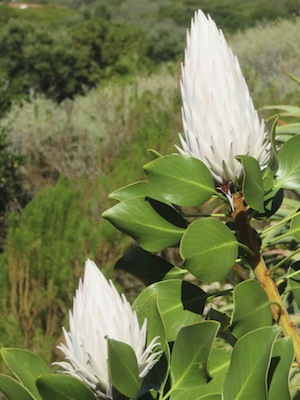 made to endure fire and drought, but don't over water drought tolerant plants
made to endure fire and drought, but don't over water drought tolerant plantsYou also need to help conserve soil water, by covering the ground and mulching as in the previous articles. I have a very small garden. I do not water anything except my vegetables and establishing plants, and would attempt to create a waterless garden even if I had more land and money for beautiful but often difficult local plants.
The information about how to water drough tolerant plants os from Heidi Gildemeister's book Mediterranean Gardening: A Waterwise Approach (1995) and Ernst Van Jaarsveld (2010) Waterwise Gerdening in South Africa and Namibia. They talk to an audience which operates on a different scale, and has more conventional aesthetics about how far to go with water-wise gardening. Conventional for a decade or so back, though, before the drought. I hope, like Californians, that South Africans with a lot of resources will majorly rethink how they use drinking water, but at present it is not illegal to be a rather self indulgent where water use is concerned in our country.
Install irrigation before planting
If you are going to irrigate, you need to lay your main supply hoses underground to hide them, and install need-based (not timed) drip irrigation. Van Jaarsveld talks about timed irrigation and Gildemeister warns against its wastage. I would say do not irrigate at all. It is possible, nay it is very easy actually, if you adjust your beauty paradigm with regard to gardening.
Do your planting only after irrigation installation and then start garden maintenance. I am so glad gardeners with small gardens do not need all of this irrigation hardware. I choose my plants carefully, because you don't have to water drought tolerant plants and I merely supplement our rainfall patterns with a few watering cans a day from the rainwater tank or the grey water collection bin, for the food plants and my indigenous tree nursery. I find the exercise beneficial and it dovetails nicely with my daily garden inspections, saving time.
State of the art watering system
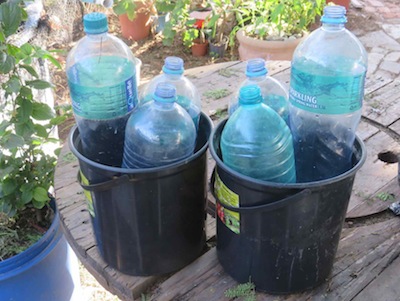 quick immersion quick immersion |
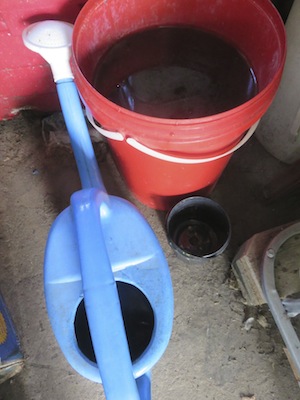 two for balance two for balance |
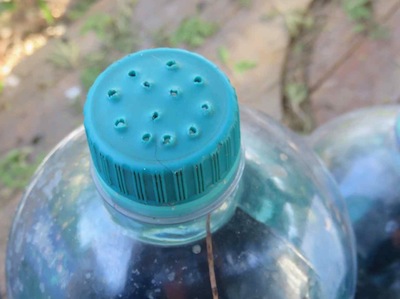 you've seen my fine sprayer for seed and seedlings
you've seen my fine sprayer for seed and seedlingsWhen to water in the Mediterranean
To replace water lost through transpiration, one can irrigate, or reduce water loss with shade, mulching and wind protection. If you need to water, watering in the morning allows penetration whereas evening watering encourages fungi as the plant’s leaves and the soil surface stay damp for longer, says Gildemeister.
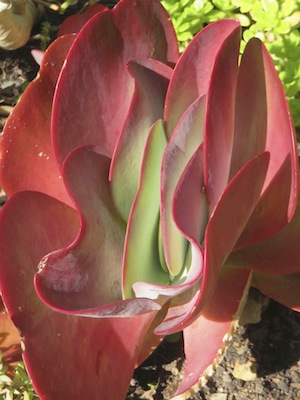 Not thirsty ! don't over water drought tolerant plants
Not thirsty ! don't over water drought tolerant plantsWhen to water in South Africa
However there are conditions of drought, either regular or irregular weather patterning, where drying out is a greater danger than fungal growth. There may be plants that are in so much need of water (like European vegetables) but growing in a hot, dry climate, that the cool dampness of night watering is ideal. For me this is the leaf vegetables. Watering with a good long slow soak at night also allows for greater water penetration. Van Jaarsveld recommends watering in the evening. Our climate is harsher and maximizing on water penetration is needed. He also recommends either hand watering or drip irrigation (Van Jaarsveld 2010:21) for those plants that need it, but usually you don't have to water drought tolerant plants in Mediterranean climates at all, unless the winter rains do not come.
Water holding tanks
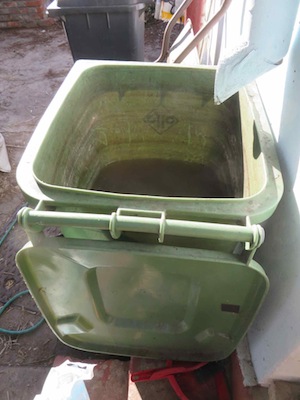 grey-rain mix grey-rain mix |
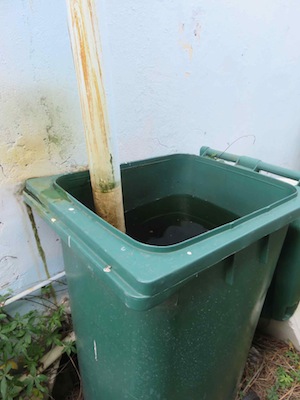 pure rain barrel pure rain barrel |
Don’t wet the leaves
How ever you water, do not wet the plant’s leaves, especially not Mediterranean plants. Some tropical plants such as orchids, and those plants which are succumbing to the heat and wilting in an exceptional heat wave may appreciate foliar spraying, however (Gildemeister 1995: 70).
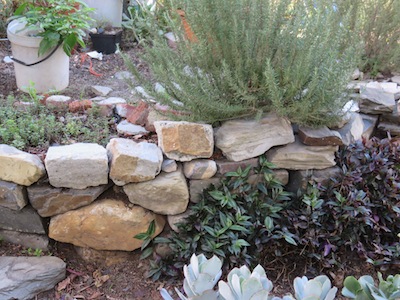 Meso-American, Mediterranean, Madeiran and Native plants
Meso-American, Mediterranean, Madeiran and Native plantsIt may not be necessary to water drought tolerant plants at all
Gildemeister explained concerning the adaptions of drought resistant plants, water saving plants lose less water through their leaves and grow more slowly in the dry and hot weather, and have wider spreading and deeper root system than thirstier plants.
Do not water drought tolerant plants when dormant
Leave dormant plants alone
Plants evolved for Mediterranean climates with its rainfall extremes should be left alone in summer. Do not water these drought tolerant plants. Irrigation spoils their vitality. These plants are especially incompatible with lawn watering regimes. Do not allow lawn sprinklers to spray or water drought tolerant plants. A few, like Osteospermum and palms are tolerant of water. We must remember that in garden care, watering is not the answer to everything. The most important work is understanding the needs of your plants. Although most plants require the most water in the hot dry months, this is not true of Mediterranean climate plants. Gildemeister gives examples. This will be dealt with when we write about plant choices. Bulbs with a dormant period in summer need their summer baking. Trees may become waterlogged in winter. You should open your tree basins to let water escape in winter (Gildemeister 1995:70). I’d add the caveat that this depends on climate. In a winter rainfall desert they need all the moisture they can get, depending on species, you don't have to water drought tolerant plants and they may need to be protected from excessive rain around roots.
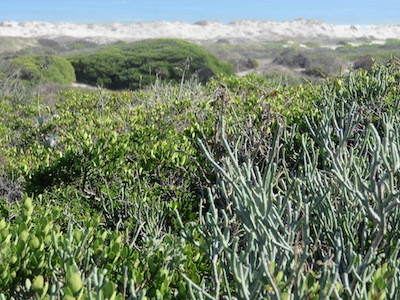 you don't have to water drought tolerant plants like these
you don't have to water drought tolerant plants like theseWater on demand
Design and develop your garden to rely utterly on winter rain. Limit irrigation to those plants which would die without irrigation, and in South African conditions with worsening drought do not plant them at all, unless it is for food. You will thus not water drought tolerant plants in summer. Allowing the others to get by with much less, even if they are less lush, is very good for their drought tolerance. They will put down deeper roots, and curtail above ground growth, both of which help them survive drought. Sometimes in the rainy season, in late winter, there are hot sunny days. Now, or after wind, some plants like orchids may be stressed and a light spray on the leaves will make them recover as they probably need high humidity at leaf surface (Gildemeister 1995:70).
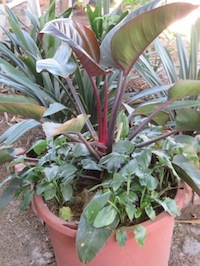 low water use Philodendron low water use Philodendron |
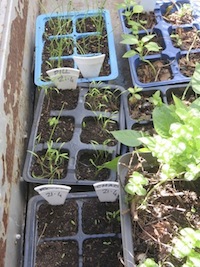 high water use vegetable seedlings high water use vegetable seedlings |
Correct quantities
It may be hard to determine what the exactly ‘right’ quantities of water are, as it depends on things as diverse the plant’s nutritional needs, surrounding plant cover, the soil, microclimate, recent watering and current weather. However, Gildemeister (1995:70) supplies some general guidelines.
Watering establishing plants
the first two years
Only water drought resistant plants while establishing them. Most drought tolerant plants require weekly watering during establishment year. In the second year only once and only in summer will do. During the establishment year a well mulched plant with a large root ball (this too is relative) will need watering once a week, while others may need it more than once a day if drooping. This is all very vague information for which feeling and experience are required, and its certainly beyond an irrigation timer’s brain. No wonder people overwater if they are able to.
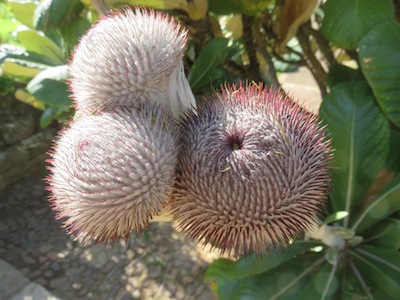
Established plants
Once established you can water drought resistant plants once a month without harming them. In very well drained soil, the more water demanding ones can get by with watering once a week. Gradually reduce watering as winter approaches. I found that due to my plant choices, of really hard drought tolerant native plants, that after the first year I did not need to water at all. Even my fellows doing the horticultural certificate did not believe this was possible. They are educated into an irrigation and imitation of English gardens mindset, and setting up irrigation systems is a big money spinner for a gardener. I hope things have changed, for the good of the country. Truly, as Gildemeister (1995:70) says, overwatering is more common. In California the lawns are overwatered with double the amount of water they need. Considering the contribution of garden watering to drinking water consumption it’s a disaster in the making.
Water seldom, slow and deep
Gildemeister’s (1995:70) watering instructions are extremely insightful. Water thoroughly, when you water, and allow the soil to become moderately dry between waterings. Water slowly because dry soil repels water and it will all run off somewhere. Pre moisten the soil once or twice before the big soak with a light watering and then go to the heavy watering half an hour later. Also water planters, pots and containers very slowly, they have established routes or cracks in the soil through which excessive water runs rapidly before the soil moistens and swells. Make watering basins around the drip line of trees and bushes and fill them twice in a row. Make the rings larger for demanding plants. Fill the rings with soil as the plants become established. They should continually be enlarged as the edges of the basin y spread the roots outward. Let ditches bring rain water to areas covered by dense leaf canopy.
Why we use 1500 litres per person per month
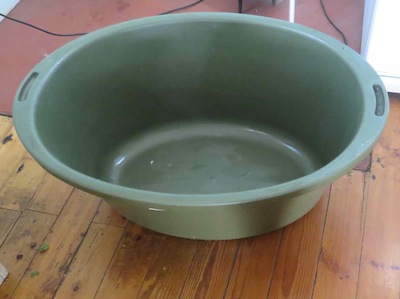 fullbody immersion in 12 L fullbody immersion in 12 L |
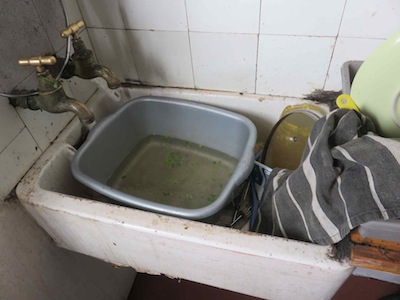 dishes and food dishes and food |
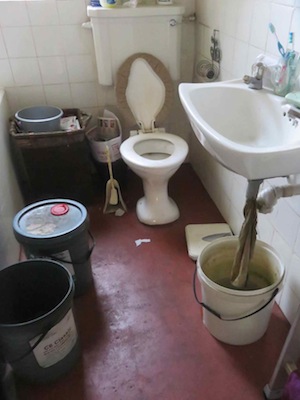 other water use mysteriously curtailed
other water use mysteriously curtailedHand watering
By hand watering, Gildemeister means watering with a garden
hose rather than irrigation. I would mean watering with a can. It is a question
of scale. Watering my tiny garden with a hose would be extremely wasteful,
unless the hose was for emptying the gray water barrel.
If you have a larger garden and you are using a garden hose, it should be low pressure. Move it around the periphery of the plant, encouraging root growth outward, and deep penetration due to the soaking, while also soaking around neighbouring plants. Water upslope from plants. Water rocks if they drain onto surrounding plants rather than watering the soil around the rock.
Watering by hand is an excellent on-demand method of supplying water to your garden while transitioning to dry gardening. Once established you may not have to water drought tolerant plants.
Replace vanished mulch, do not let the earth become bare (Gildemeister 1995:70).
and so on to the last article....
This article on how to actually water the drought tolerant and other plants in your garden was the last in the series of how to articles on water-wise gardening in the summer drought Mediterranean climate zones. Putting watering last in a water-wise series may seem strange, but actually you have seen that so much has to be in place to help with water conservation before we even get to the watering itself. I conclude the series with the next article on the don'ts of water management, the ecological faux pas of the past and present. I think it makes for interesting reading. However, this is not really the end. A series on plant lists for specific purposes and places, because plant choices are such a large part of saving water, is planned. There will also be a section in it on trees and the ecology of forests and water-wise food growing is also in the design stage. I still need to do a lot of research though.
------
home page for links to tons of useful information on natural gardening
------
natural garden design, its benefits
------
album of water-wise and no-water ground cover choices
Restore Nature Newsletter
I've been writing for four years now and I would love to hear from you
Please let me know if you have any questions, comments or stories to share on gardening, permaculture, regenerative agriculture, food forests, natural gardening, do nothing gardening, observations about pests and diseases, foraging, dealing with and using weeds constructively, composting and going offgrid.
You’re a home gardener ! Share your experiences and questions !
We all know about home gardening. Tell us about your successes, challenges and ask about issues that bother you. You may have the luxury of a back garden, but there are other ways we learn. Few people age without growing something or buying vegetables during their lives ! It is absolutely guaranteed that you have learned things which can help others on their gardening journey.
We invite you to share your stories, ask questions, because if a thing has bothered you it will bother others too. Someone may have a solution ! No question is too small. There is learning for everyone involved, for you, for me (yes, I learn from every question), for us all. Exciting stuff !
We are starting on a new journey. Every week we will profile your letters ! The best stories and questions we receive.
SEARCH
Order the Kindle E-book for the SPECIAL PRICE of only
Prices valid till 30.09.2023
Recent Articles
-
garden for life is a blog about saving the earth one garden at a time
Apr 18, 25 01:18 PM
The garden for life blog has short articles on gardening for biodiversity with native plants and regenerating soil for climate amelioration and nutritious food -
Cape Flats Sand Fynbos, Cape Town's most endangered native vegetation!
Apr 18, 25 10:36 AM
Cape Flats Sand Fynbos, a vegetation type found in the super diverse Cape Fynbos region is threatened by Cape Town's urban development and invasive alien plants -
Geography Research Task
Jan 31, 25 11:37 PM
To whom it may concern My name is Tanyaradzwa Madziwa and I am a matric student at Springfield Convent School. As part of our geography syllabus for this
"How to start a profitable worm business on a shoestring budget
Order a printed copy from "Amazon" at the SPECIAL PRICE of only
or a digital version from the "Kindle" store at the SPECIAL PRICE of only
Prices valid till 30.09.2023







